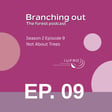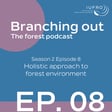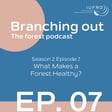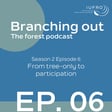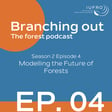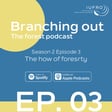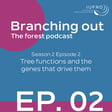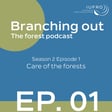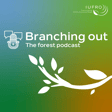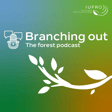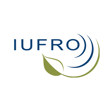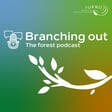Become a Creator today!Start creating today - Share your story with the world!
Start for free
00:00:00
00:00:01

Episode 5: A century of wood
In this episode of Branching Out, host Jose Bolaños is joined by Franka Brüchert and Roger Meder, Co-Coordinators of IUFRO Division 5 Forest Products, to explore how wood can define the 21st century. From traditional timber to cutting-edge innovations like beech wood textiles featured at Berlin Fashion Week, the conversation dives into the versatility, sustainability, and future potential of forest products. Discover how wood is reclaiming its place in architecture, fashion, and global markets—and why Division 5 is considered the heart of forestry.
Transcript
Introduction to Wood's Central Role in the 21st Century
00:00:01
Speaker
Willem de Riker, he was saying that ah the 19th century was the century of steel and the 20th century was the century of concrete. But he saw the 21st century as being the century of wood.
00:00:13
Speaker
We've used wood for centuries, for millennia, for for cooking, for heating, for construction. and And I think we're seeing now those same sectors returning our global economy.
Launch of 'Branching Out' Podcast and IUFRO Focus
00:00:34
Speaker
Hello everyone. I'm your host, Jose Bolaños, from the International Union of Forest Research Organizations, IUFRO, the Global Network for Forest Science Cooperation, and you're listening to season two of Branching Out, the Forest Podcast.
00:00:47
Speaker
It's great to have you with us as we explore more forest science. We have reached the first half of the season and cover a Euphros Division 1, 2, 3, 4. Today we have the co-coordinators of Division 5, Forest Products.
00:01:01
Speaker
Welcome to Branching Franca and Roger. We'd love to hear a little bit about your journey, so please go ahead and introduce yourself.
Expert Backgrounds: Biology and Wood Anatomy
00:01:08
Speaker
My name is Franke Brücher. I'm a senior research scientist in Germany, at southwest of Germany, European-based.
00:01:17
Speaker
And my background is as a trained biologist. So wood anatomy, wood morphology, how wood develops and so that brought me from biology into forest products on the intention to understand better how all these properties define wood quality and the use of wood. So that is my background.
00:01:42
Speaker
I'm doing that now for approximately 30 years and yeah there was a little bit of experience in there but still a lot of new things to explore.
Journey from New Zealand to Australia in Forestry Research
00:01:51
Speaker
Yeah, hi, I'm Roger Meadah. I'm a chemist by training, background in analytical chemistry, and I really entered the forestry sector back in the mid-90s by working at New Zealand Forest Research, where I started out working with pulp and paper, adhesives, timber preservatives, and so on, everything that a chemist does with wood.
00:02:15
Speaker
I moved to Australia where I joined CSIRO, Commonwealth Scientific and Industrial Research Organisation, and was leading a group dealing with and rapid testing, I guess, is what you'd call it in understandable terms, where we're applying methods to rapidly characterise properties of interest of timber, density, chemical composition, and stiffness and and so like In Australia, it focused very much on eucalypt plantation, whereas New Zealand was centred very much around radiata pine.
00:02:46
Speaker
I was introduced to IUFRO through Dave Cowan, who at the time in New Zealand was the coordinator of Division 5. Dave had a very illustrious career studying density, and it was him that encouraged me to to branch out and and interact with IUFRO.
00:03:10
Speaker
Excellent, welcome.
Scope of Division 5: Wood and Non-Wood Products
00:03:11
Speaker
And going to topic, in the first season, on the third episode of the podcast, there were a lot of examples of non-wood forest products from Kenya, from Latin America and from China, and their contribution to the local economies.
00:03:25
Speaker
Now, could you tell us a little bit in detail what Division 5 is all about? What are forest products and what is the research you do focus on and why is it important? I think Division 5 for me is is really the heart of forestry.
00:03:40
Speaker
It's a very diverse division. As you say, we cover nothing from traditional wood products. You talk forest products, everybody immediately thinks pulp and paper, timber, construction. But of course, there are a large number of non-wood products as well.
00:03:55
Speaker
Everything from foodstuffs, fruits, berries, through to handcrafts, through to cultural elements that we manage from, not so much from a plantation forest, but from a natural forests.
00:04:09
Speaker
But for me, Division 5 is where we make use of our
Young vs. Old Forests: CO2 Reduction Capabilities
00:04:14
Speaker
forests. And I think this is a double-edged sword because at the same time, this is where we run against some of our our largest contenders in terms of, I guess, the green groundswell.
00:04:27
Speaker
and And I'll call them tree huggers. You know, no one wants to cut down a tree, but we grow plantation forests exactly for that in order to preserve natural forest. The reality of it is that a continual renewal of our plantation forests actually one of the best tools we have for overcoming CO2 increase within our atmosphere. Because young forests sequester carbon out of the atmosphere at a rate greater than anything else on the planet. Old forests will do so, but the older trees, say they're old, they slow down a little bit. Whereas a young plantation forest can sequester estimates from two through to six through to eight metric tonne CO2 per hectare per year.
Research Highlights: Properties, Processing, and Trade
00:05:11
Speaker
CO2 is then captured by the tree, turned into wood, and that's what we utilise for our paper products, for our our timber products, for our new mass timber, cross-laminated timber housing that has far more to offer
00:05:26
Speaker
as a green alternative than concrete and steel. So I love Division 5. It's the heart of the business. The division as such is divided in, now at the moment, 10 research groups. And the research groups cover everything from understanding the properties and their role for water quality, but also processing. Then it's biorefinery, bioenergy, and it's also marketing. and coming from the the raw material to the product as such, so it's also processing. It's understanding particular species groups like teak and eucalypt or also babu and rattan.
00:06:11
Speaker
as properties. And so very importantly now in a very active group is at the moment really wood identification so that we know with all the international trading and marketing where does the material come from and that is a very important part of the story at the moment.
00:06:33
Speaker
say The division as such, it not only focuses on the product as such, but also on the methods, how to describe it. As Roger said, it's so diverse so from mass timber for construction.
00:06:50
Speaker
all the way to energy consumption. There's such a variety in methodology in there and that is covered as it also covers life cycle assessment to look at the whole thing as such, so how much is in there for a circular bioeconomy.
00:07:15
Speaker
And it's wood protection as well to show how long-lasting wood actually can act as a material. And that gives me a lead to go into the next question within 2025.
Forests' Role in Food Security and Management Innovations
00:07:29
Speaker
Forests and foods was the theme of the International Day of Forests, which basically celebrated the crucial role of forests in food security, nutrition and livelihoods.
00:07:40
Speaker
Are there any innovative approaches to enhance the management and market access of these products? the food products that is something which is a very local and regional organized sector and it is important to the people in the regions.
00:08:01
Speaker
And to make that innovative on a wide stream, I actually don't know how this can be better promoted than by supporting the people on the regional level.
00:08:15
Speaker
I guess, yeah, very regionally based and culturally based medicines and foodstuffs from forests are really important because they're things that are lost science if we don't promote and acknowledge and work to understand them.
00:08:34
Speaker
um In some parts the world, of course, it you know the forests are the local supermarket. They provide a lot of food for a number of what would otherwise be poorly sustained population around the world. More specifically, say that the Euphro itself had a task force on the issue and that our colleagues Carsten Smith Hall and… um I forgot his first name. Yeah, Jim Chamberlain, that they actually worked on this task force and that there is a report on non-food products from Forrest and its role in the bioeconomy. And they actually published a paper, peer review paper,
00:09:24
Speaker
on that last year, on the global views on that. So it is an important issue, it's been tackled. But I really think that non-timber forest products as an innovation is it kind of, say, very often it's taken up very traditional ideas and brought that to a wider auditorium, to a wider world.
00:09:51
Speaker
So a lot of that is long-used knowledge, which then, say, the innovation is that it's brought to a wider public, that the innovation lies in the marketing and not in the product as such. i Moving on to the obstacles. I know, you know, on every research field we have the different obstacles. So what stands in the way of innovation in terms of forest product research?
Addressing Challenges: Market and Regulatory Pressures
00:10:18
Speaker
I think this is also where we we've come against competing products. you the The ability to use concrete and steel in construction has been with us for decades now.
00:10:32
Speaker
And wood, I guess, went through a period where it had a poor reputation. It's it's prone to rot and deterioration, but then so are concrete buildings.
00:10:44
Speaker
But our understanding now, as Frank has said, of wood protection and not only chemical preservatives, but wood protection systems where it is part of an engineered system has brought us to a stage now where we're seeing the the advent of these multi-storey, and these are multiple-storey, 10-storey, 14-storey, high-rise wooden buildings from mass timber. I had the opportunity, one of our first multi-stories went in into Melbourne. It was a a public building, a library, and people were walking up to it and touching the wall. They were fondling the walls.
00:11:25
Speaker
You don't see people do that with concrete building and with steel. There's a tactile nature of that makes it so much more acceptable and nurturing to the consumer.
00:11:36
Speaker
So that is our real advantage, and we don't make enough of that. I feel, in promotion of timber. um I think that the challenges we face are one of market competition and and innovation. You're right. We use wood for such a long time, for hundreds thousands of years,
00:11:56
Speaker
And its use has developed and the way it goes into different utilization and and in different products. But at the moment, I would say it is necessary really to look at also carbon recycling and and all these issues in coming to yeah circular use, a reuse of material.
00:12:22
Speaker
And there are advantages for work. And then you need from that again an upscaling to industrial processes. So i think that all that is one obstacle. Or that you have regulations in in building. Building your regulations are also very persistent. so Because you need to prove a lot in security and that takes a while to shift that to new knowledge and new expertise.
00:12:52
Speaker
Gloomlem is an example that i think probably two decades to find its way to the market. So you need to be patient and you need to be persistent. You need to find people who follow you with your idea.
00:13:08
Speaker
That is nothing really from one day to the other or from one year to the other. Wood has so many advantages over other products in terms of its machine ability, its tactile nature, the ability for it to be moulded into features that you just can't do with any other product.
00:13:30
Speaker
I think the challenges are ah of our own making. We feel, certainly I feel, that I always have to stand up for timber. and that I'm i'm always apologizing that I'm cutting down another tree or or i'm utilizing a wood product.
00:13:45
Speaker
It should be a go-to product. It's probably an old statistic, but it's probably still quite relevant today. It's estimated that some 50% of the the world's population still uses wood for heating and cooking. And yet, within iUFRO, we're looking at, I guess, the high end of that in energy utilisation from timber or from wood. We look at cellulosic fuels, lignin-based fuels, and that is available from wood and wood.
00:14:14
Speaker
particularly from wood waste streams and recyclable streams, I think is going to be an important component of our energy use going forward.
00:14:25
Speaker
I think the really important thing about wood as a material is that it's got endless uses in a large number of Somewhat disparate sectors, everything, as i say, from construction through to pharmaceutical through to bioenergy.
00:14:43
Speaker
And I think that's where Division 5, while it is a diverse division, has a lot of cohesion. Because what is one research group's waste product becomes the feedstock for another research group.
00:14:56
Speaker
I think in Euphro, if you are in Division 5, you are a person which lives for wood and solves almost, or tries to solve almost all problems with wood.
00:15:10
Speaker
From last season, I also remember some innovative and surprising applications such as a medical cast made of wood sheeps and all the architectural designs, the implications for bio-economy. What are recent discoveries in forest product research that you think deserves everybody's
Wood's Potential in Bio-Based Industries
00:15:30
Speaker
attention?
00:15:30
Speaker
I think there's some interesting work going on in the area of bio-based plastics. And again, there was some work within CSIRO 10, 15 years ago, looking at a oil-based substitute terephthalic acid with great success.
00:15:49
Speaker
The challenges there though now become scaling that to the scale required to produce the volumes required. But it does mean that there are...
00:16:00
Speaker
potential alternatives to petroleum-based plastics? Yeah, I think that is um say all what we would say say of bioeconomy using residues or by-products from processing or allocate particular compartments of the tree to to these um streams, there there is a lot in there.
00:16:31
Speaker
For decades, a problem with low-grade, so-called low-grade beach compartments, which would go into bioenergy as a fuel, which is now used for fibre, say for plant fibres, woody fibre.
00:16:51
Speaker
and carbonized fibers. The process for spinning has been improved for such fibers, so that goes now into material for fashion.
00:17:03
Speaker
There was a collection of a designer on the Berlin Fashion Week, purely knitted or sewn, made from that beach material fibers.
00:17:14
Speaker
So that is an innovation. so Even if it's niche product that you can use, ah maybe a slightly crooked stem section, I would rather like to see that in construction than go to a product where you need to break up the wood structure because that needs energy.
00:17:36
Speaker
the IUFRO, All Division 5 conference, which takes place every five years. And the next one is a scheduled for
Upcoming Division 5 Conference and Global Interest
00:17:45
Speaker
2021. So what do you expect from this change of scientific, professional, and technical information on Forest Bay?
00:17:51
Speaker
We're just in the course um of an identifying partners to organize that conference. We had a call for bids and that we had a hope to have the next conference in South America because we we want the All Division 5 conference to tour around the regions.
00:18:12
Speaker
What strikes me is that we are seeing interest from regions of the world where traditionally Division 5 hasn't had a very strong representation. And I find that exciting because it means that there's an opportunity there to be exposed to some different ideas and and hopefully some some new innovation. Any last thoughts before we close? Yes, say I would like to invite people really to look at the EUFRA pages and our division page in particular and the ones who are already involved in research doing
Engaging with IUFRO's Network and Resources
00:18:51
Speaker
that. Have a look also at the conference and at the events.
00:18:56
Speaker
which are organized by the research groups, by the working groups. I think there's a very, very good program for that the running year. Find your way to the mailing list and yeah put your name in the mailing list because so that was the way how I got into Euphro to contact people who work on a similar topic and, yeah,
00:19:24
Speaker
network throughout the world and I'd say that is so inspiring and this is why I really love to be with you for hope. I think forest products as a division and forest products as a concept went through a period in the 80s, 90s where we were shunned. Forest products was a bad word.
00:19:45
Speaker
We were the ones that cut down trees. Despite having a whole lot of tools in in my chemistry lab, I also had ah a chainsaw in in the back of the ute and and I We'd go and cut down trees at a time when that really wasn't the thing to do because forest products and forest plantations were not distinguishable from deforestation.
00:20:07
Speaker
It upset me because I saw so much potential for forest products. um I think we're starting to see that come back now. as technology is improving around, particularly in the that biotechnology sector.
00:20:23
Speaker
And with that, I'd like to thank you and the rest of our guests here today. Thanks to Franca and Goyer. I thank you, Jose and Franca, for having the chance to chat with you as well. so And thank you to our listener. Look out for the next Branching Out episode, where we will explore the sixth division of our Euphro.
00:20:42
Speaker
And if you want to know more about a Euphro, follow our social media or click on the link on the show notes. Goodbye!
